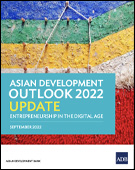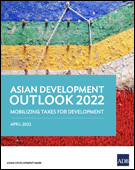Review of Maritime Transport 2022Ships carry over 80% of the volume of global trade. In South Asia, intraregional shipping connections increased as India improved its shipping connections to Pakistan, Sri Lanka, People's Republic of China, the Republic of Korea, Malaysia, Saudi Arabia, Singapore, and the United Arab Emirates. The most connected port in South Asia is the Colombo port in Sri Lanka; the Colombo port ranked the 24th best port in the world in 2021. Author: United Nations Conference on Trade and Development Year: 2022 Download Tags: India, Sri Lanka, Transport, Trade, Global Value Chains Role of Northeast Indian States in Shaping India's Logistics PerformanceThe Government of India launched the National Logistics Policy in 2022 to improve the ease of doing business in the country. The policy integrates infrastructure and network planning and aims to make logistics services and human resources more efficient. This paper explains the current status of logistics and connectivity in India as well as the northeastern region's potential to expand domestic and international trade. The paper also identifies opportunities and initiatives to improve logistics performance. Author: Bijaya Roy and Mihir Shekhar Bhonsale Year: 2022 Download Tags: India, Logistics, Regional Connectivity Leveraging Thematic Circuits for BIMSTEC Tourism DevelopmentThematic tourist circuits in the BIMSTEC region can help boost economic recovery from the pandemic and promote a return to pre-COVID-19 tourism growth. However, to fully realize the benefits of cross-border tourism and create thematic circuits, multiple issues need to be addressed throughout the region. This report focuses on COVID-19 recovery, infrastructure, marketing and products, human resources, policy, and investment areas, and recommends actions for each to help hasten the recovery and aid in creating thematic circuits. Author: Asian Development Bank Year: 2022 Download Tags: BIMSTEC, Tourism, COVID-19 BIMSTEC Trade Facilitation Strategic Framework 2030The BIMSTEC Trade Facilitation Strategic Framework 2030 suggests a structured pathway approach for enhancing the environment for trade facilitation among BIMSTEC member states. This framework outlines development of various soft infrastructure, hard infrastructure, and capacity-building strategies. It has also identified seven principles to guide implementation of the BIMSTEC Trade Facilitation Strategy, namely, (i) country ownership, (ii) results-orientation combined with pragmatism, (iii) flexibility and responsiveness to country needs, (iv) reform and modernization, (v) active participation and involvement of the private sector, (iv)partnerships with development partners, and (vii) mutual cooperation. Author: Asian Development Bank Year: 2022 Download Tags: BIMSTEC, Trade Facilitation, Infrastructure Asian Development Outlook (ADO) 2022 Supplement: Global Gloom Dims Asian ProspectsSouth Asia is projected to grow at 6.5% in fiscal year (FY) 2022 and 6.3% in FY2023. In Bangladesh, weak exports and high inflation are hampering recovery, while in Bhutan, agriculture and construction are projected to support economic growth. In India, growth is projected at 7.0% in FY2022 and 7.2% in FY2023, sustained by public reform and public and private investment. Maldives tourist arrivals and construction continue to pick up. In Nepal, the 2023 budget aims to improve agriculture, industry, and social protection. Economic contraction is expected in Sri Lanka with marked declines in industry and agriculture. In Southeast Asia, Myanmar maintains positive growth projections despite high rates of inflation. Author: Asian Development Bank Year: 2022 Download Tags: ADB, Agriculture, South Asia, Southeast Asia, Investment, Social Protection Trade and Development Report 2022South Asia is projected to expand at 4.9% in 2022 amid inflation and high energy prices. Balance of payment constraints in Bangladesh and Sri Lanka have led these countries to place restrictions on the consumption of electricity. In India, where the economy expanded by 8.2% in 2021, the easing of supply chain disruptions and the rise in domestic demand has led to a deceleration in growth. Author: United Nations Conference on Trade and Development Year: 2022 Download Tags: UNCTAD, Trade, South Asia Significance of Padma Bridge in South Asia's ConnectivityThe Padma Bridge will improve connectivity and increase trade in the Bangladesh. The bridge increases connectivity in Bangladesh and is projected to improve the quality of life among nearby communities. The economies of nearby countries also stand to benefit, as the bridge improves connectivity among Bhutan, India, and Nepal, and improves mobility of people, goods, and essential services. Author: CUTS International Year: 2022 Download Tags: Transport, Trade, BBIN, Bangladesh, Bhutan, India, Nepal Key Indicators for Asia and the Pacific 2022Key Indicators for Asia and the Pacific 2022 provides statistics on economic, financial, social, and environmental measures, as well as select indicators for the Sustainable Development Goals (SDGs). Statistics for Asian Development Bank's member countries include numbers for energy and electricity, transport and communications, and international trade. Author: Asian Development Bank Year: 2022 Download Tags: ADB, South Asia, Sustainable Development Goals  South Asia Economic Focus (Fall 2022) Coping with Shocks: Migration and the Road to ResilienceReal gross domestic product (GDP) in South Asia is projected to slow to 5.8% in fiscal year (FY) 2022 and FY2023. In Bangladesh, real GDP growth is projected at 6.1% in FY2022-2023, as higher inflation and rolling power outages dampen post-coronavirus economic recovery in consumption and investment. The easing of mobility restrictions is supporting Bhutan's recovery amid one of the highest vaccination rates globally. With slower domestic demand, real GDP forecast in Bhutan is set at 4.1% in FY2022-2023. In India, where exports and overall economic activity have recovered more strongly than the rest of the world, growth is forecast at 6.5% in FY2022-2023. In Maldives, real GDP is expected to grow by 12.4% in FY2022 and 8.2% in FY2023 on the recovery of tourism. Growth forecast in Nepal is set at 5.1% in FY2022-2023 amid normalization of monetary policy. Real GDP in Sri Lanka is projected at -9.2% in FY2022 and -4.2% in FY2023 due to a severe balance of payment crisis and risks posed by the country's political situation. Author: World Bank Year: 2022 Download Tags: WB, South Asia World Investment Report 2022 In 2020–2021, foreign direct investment (FDI) in South Asia fell by 26%, to $52 billion, with large mergers and acquisitions from 2020 not repeated in 2021. Flows to Bangladesh rose by 13% to $2.9 billion, while inflows to India declined to $45 billion. However, India announced new international project finance deals, including 23 in renewable energy. Outward FDI from South Asia, mainly from India, rose by 43% to $16 billion. Author: United Nations Conference on Trade and Development Year: 2022 Download Tags: UNCTAD, Trade, South Asia, Bangladesh, India, Renewable Energy  Asian Development Outlook (ADO) 2022 Update: Entrepreneurship in the Digital AgeGrowth forecast in South Asia is projected at 6.5% in fiscal year (FY) 2022 and FY2023. In Bangladesh, gross domestic product (GDP) growth is projected at 7.2% in FY2022 and 6.6% in FY2023, reflecting lower consumption spending. Growth in Bhutan is forecast to grow at 4.5% in FY2022 and 4.0% in FY2023 as government investment continues as a key driver of growth. In India, weaker than expected global demand is expected to affect growth, projected at 7.0% for FY2022 and 7.2% for FY2023. GDP growth in Maldives is forecast at 8.2% in FY2022 and 10.4% in FY2023 with continued tourism arrivals. In Nepal, GDP is projected at 5.8% in FY2022 and 4.7% in FY2023, affected in part by needed policy tightening to address rapid rise in imports. Contractions are projected for Sri Lanka, -8.8% in FY2022 and -3.3% in FY2023, likely resulting from severe macroeconomic challenges, including the impact of the ongoing crisis. In Southeast Asia, Myanmar's GDP is forecast at 2.0% in FY2022 and 2.6% in FY2023 owing to an improvement in economic activity. Author: Asian Development Bank Year: 2022 Download Tags: ADB, Bangladesh, Bhutan, India, Maldives, Myanmar, Nepal Economic and Social Survey of Asia and the Pacific 2022: Economic Policies for an Inclusive Recovery and Development Rapid economic growth in Asia and the Pacific in the last three decades have lifted many out of poverty, through improvements in agriculture and manufacturing. Nevertheless, many countries have experienced increases in inequality in their countries since the 1990s. This publication argues that Asia-Pacific countries should prioritize inclusive growth, by allowing those from all socioeconomic groups to improve livelihoods, incomes, and education. While fiscal and health challenges posed by the coronavirus pandemic present challenges, achieving inclusive recovery is still very possible. Author: United Nations Economic and Social Commission for Asia and the Pacific Year: 2022 Download Tags: UNESCAP, COVID-19, Trade  Reshaping Norms: A New Way ForwardSouth Asian countries are emerging from coronavirus (COVID-19) pandemic burdened by high inflation and fiscal imbalances, as well as external shocks. In Bangladesh, gross domestic product (GDP) is projected to increase by 6.4% in fiscal year (FY) 2021-2022 and 6.7% in FY2022-2023. In Bhutan, FY2021-2022 growth is estimated at 4.4% and FY2022-2023 growth at 4.7%, with the expected return of international tourists and migrant workers from India. In India, FY2022-2023 growth is projected at 8%, slightly below last year’s rate. Economic recovery in Maldives will stay strong in 2022, with real GDP growth expected to grow by 8.5% in 2022 and 9.1% in 2023. In Nepal, tourism has yet to recover, with growth projected at 3.7% in FY2021-2022 and 4.1% in FY2022-2023. Hydropower in Nepal is providing a natural hedge against increases in crude oil-based energy prices. Growth in Sri Lanka is hampered by a series of shocks amid high debt, with 2022 growth projected at 2.4%. Author: World Bank Year: 2022 Download Tags: WB, South Asia, Bangladesh, Bhutan, India, Maldives, Nepal, Sri Lanka National Single Window: Guidance NoteElectronic national single window systems help stakeholders meet trade and transit requirements. Single windows allow trade and transit sectors to send information to multiple agencies through one platform, thereby helping reduce processing time and the cost of doing business. This guidance note compiles information on planning and implementing national single window systems that help countries comply with international trade regulations. Author: Asian Development Bank Year: 2022 Download Tags: ADB, National Single Window, Trade, Transport Basic Statistics 2022Basic Statistics presents economic, environmental, and social indicators used to track progress toward the Sustainable Development Goals. The publication includes new data for development indicators for 46 economies in Asia and Pacific, including those for the seven South Asia Subregional Economic Cooperation countries: Bangladesh, Bhutan, India, Maldives, Myanmar, Nepal, and Sri Lanka. Author: Asian Development Bank Year: 2022 Download Tags: Bangladesh, Bhutan, India, Maldives, Myanmar, Nepal, Sri Lanka, Trade, Sustainable Development Goals, Renewable Energy  Asian Development Outlook (ADO) 2022: Mobilizing Taxes for DevelopmentGrowth in South Asia is projected to remain strong at 7.0% in FY2022 and 7.4% in FY2023 as the region’s economies try to catch up to pre-pandemic levels. In Bangladesh gross domestic product (GDP) growth is projected at 6.9% in FY2022. Growth in FY2023, projected at 7.1%, will be driven by private consumption. Bhutan is forecast to grow at 4.5% in FY2022. Growth will accelerate to 7.5% in FY2023 with the reopening of international tourism in the country. India is forecast to grow at 7.5% in FY2022 and 8.0% in FY2023, buoyed by strong investment growth. GDP growth in Maldives is forecast at 11.0% in FY2022 and 12.0% in FY2023 with continued tourism arrivals. In Nepal, fiscal stimulus and wider vaccination coverage will support growth, projected at 3.9% in FY2022 and 5.0% in FY2023. Sri Lanka's growth is forecast to slow to 2.4% in FY2022 and pick up to 2.5% in FY2023 amid low foreign exchange reserves. In Southeast Asia, Myanmar’s economy is forecast to contract in FY 2022 on protracted political instability. Myanmar GDP is forecast at -0.3% in FY2022 and 2.6% in FY2023. Author: Asian Development Bank Year: 2022 Download Tags: ADB, Bangladesh, Bhutan, India, Nepal, Sri Lanka, Maldives, Myanmar Regional Cooperation and Integration in Asia and the Pacific: Responding to the COVID-19 Pandemic and "Building Back Better"Platforms for regional and subregional cooperation helped spur collective action to help Asia and the Pacific build back resiliency from the coronavirus disease (COVID-19) pandemic. Regional cooperation platforms such as the South Asia Subregional Economic Cooperation program helped countries respond to the COVID-19 emergency. In South Asia, partners will have the opportunities to support regional market development through transport corridors, trade facilitation, and cross-border energy trade post-COVID-19. Author: Asian Development Bank Year: 2022 Download Tags: ADB, Bangladesh, COVID-19, Economic Corridor Development, Energy, India, Trade Facilitation, SASEC, ADB RCI 2022 , ADB RCI Asian Economic Integration Report 2022: Advancing Digital Services Trade in Asia and the PacificAs of December 2021, 73 South Asia Subregional Economic Cooperation (SASEC) projects worth $17.43 billion had been financed. The SASEC Program was able to sustain its momentum in 2020 and 2021 in spite of setbacks brought about by the coronavirus pandemic. In 2020–2021, the Asian Development Bank (ADB) committed $2.36 billion for 13 regional cooperation and integration projects in the subregion, including five transport projects, three energy projects, and five multisector/economic corridor projects. The SASEC Secretariat is reviewing the progress of the SASEC Vision initiatives to help make coordination mechanisms more effective and to improve resource mobilization. Author: Asian Development Bank Year: 2022 Download Tags: Trade, SASEC, ADB, COVID-19, Regional Cooperation |



